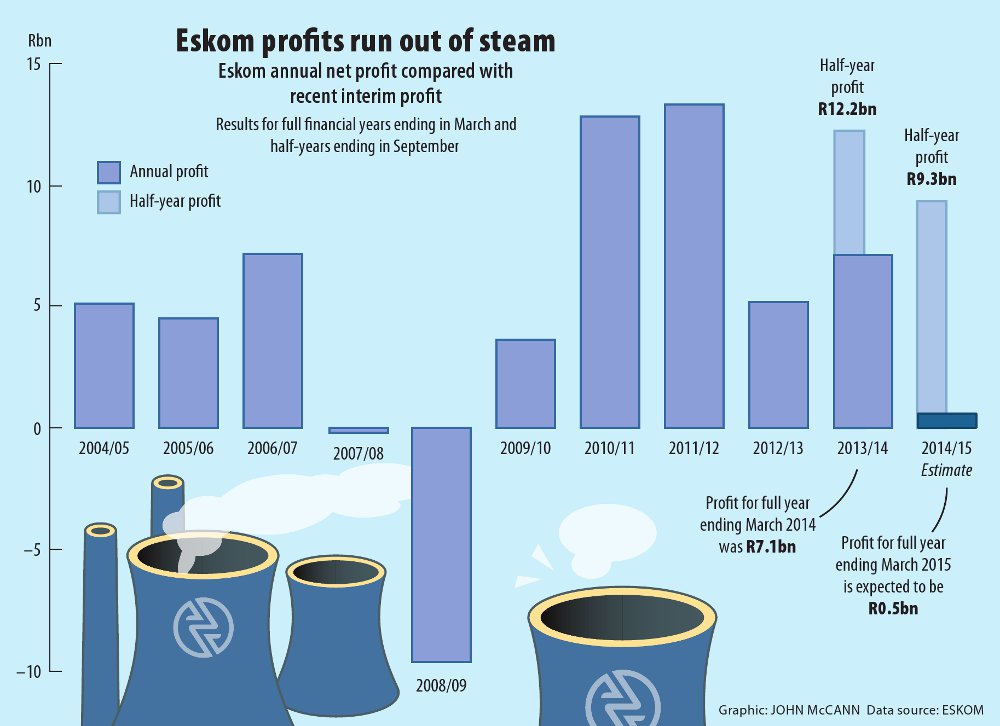Eskom says the synchronisation of unit six at Medupi
Eskom’s decision to run its diesel-fired gas turbines full-time to keep the lights on, and with the economy just ticking over, may come back to bite it in the pocket.
The turbines are five times more expensive to run than coal-fired power stations, according to analysts. They said Eskom’s overreliance on the turbines would have a huge impact on Eskom’s already precarious financial position.
The utility spent R10.5-billion on diesel in the 2013-2014 financial year to operate its two biggest turbines, although it had budgeted to spend only R2.5-billion. In the 2012-2013 financial year, Eskom spent R5-billion on diesel.
The cost of the diesel is not the only worry. Eskom spokesperson Andrew Etzinger announced on Sunday that it was concerned about the supply of diesel to the power stations because it was having to run the turbines on a “permanent basis”.
“We have a certain amount of diesel,” Etzinger said, “but not full capacity.
“If we need to run the open-gas turbines hard in the first few days of the week, we will deplete our reserves.”
Diesel concerns
The executive director of the South African Petroleum Industry Association, Avhapfani Tshifularo, said earlier this week that Eskom’s diesel supply problem was caused by the fact that it required more diesel than it had anticipated.
But PetroSA’s vice-president of corporate affairs, Zama Luthuli, said this week that Eskom’s diesel supply at its two largest turbines had normalised.
“Plans are in place to ensure that our supply to Eskom is not impacted [affected],” she said.
Peak Oil’s Jeremy Wakeford said the problems with the supply of diesel might also be because of logistical constraints. Because the turbines were running full-time, Eskom might not be able to fill the diesel storage tanks fast enough, and tankers not being able to make unscheduled deliveries could also be playing a part in the problem.
He said another concern was that, because the diesel turbines were designed to run only for an hour or two when needed during peak electricity use, Eskom would be cutting their life span by running them all day. “There is a definite possibility that these diesel-fired turbines could break down from overuse,” he said. “Also, Eskom could be using up years of these plants’ lifespan in a few months.”
Financial impact
Grové Steyn, of Meridian Economics, said the excessive use of the turbines would have a large impact on Eskom financially. He, too, said the turbines had a finite life and could do only a finite number of start-ups. “They were designed for a peaking role, perhaps one or two hours a day for only some days of some weeks,” he said.
Steyn said running them more than this would shorten their life-span and lead to increased maintenance costs – never mind the more expensive electricity they supplied.

Eskom’s chief executive, Tshediso Matona, raised these issues this week when Eskom announced its financial results for the six months that ended on September 30.
Matona said that Eskom had managed to meet demand, despite its constrained grid, by using the turbines.
“However, it must be noted that Eskom is no longer able to keep the lights on at all costs as this has dire consequences on the health of the plant,” he said.
Diesel-fired production
Eskom has four major diesel-fired open-cycle gas turbines, the largest of which is the Ankerlig power station, with a production capacity of 1 338 megawatts (MW). The second-largest is Gourikwa, with a production capacity of 746MW.
Both of these, with the Acacia power station, which has a capacity of 171MW and is generally used to provide back-up power to the Koeberg nuclear power station, are in the Western Cape.
The other is the Port Rex power station in East London, which has a capacity of 171MW.
But these are not Eskom’s only concerns. This week it announced that the synchronisation of unit six at the Medupi power station, which was planned for December 24 this year, is likely to be delayed.
Eskom said the matter was receiving “management’s full attention”, and that it was continuing to work with contractors to resolve any issues that could affect the schedule.
Emissions
This week, the utility also announced that the ash plant equipment at its Lethabo power station had failed, causing high levels of emissions from four of the six units there.
“Dedicated teams are on site and working around the clock to restore the precipitator performance and reduce the emissions,” it said in a statement.
“However, some of the precipitator fields have internal damage, which will require the unit to be shut down for repair work to take place.”
Eskom reported a profit of R9.3-billion for the six months to September 30, which was down 24% from R12.2-billion for the same period the previous year.
It said it expects these profits to decline to R0.5-billion for the full financial year, because revenue during the winter is much higher than during the summer, and maintenance is usually scheduled for summer months, which also affects its income.